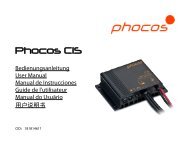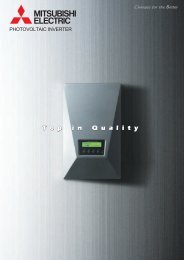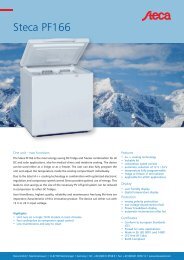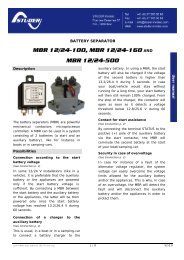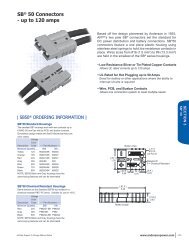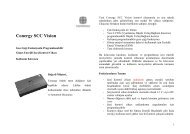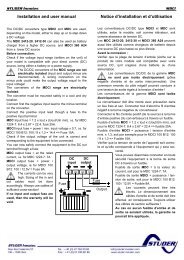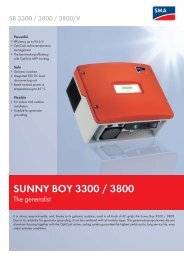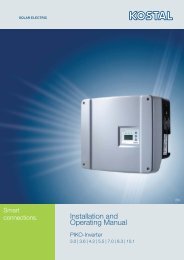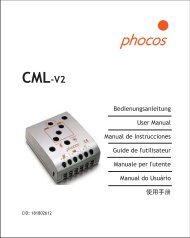Technical Manual - ODYSSEY Batteries
Technical Manual - ODYSSEY Batteries
Technical Manual - ODYSSEY Batteries
- No tags were found...
Create successful ePaper yourself
Turn your PDF publications into a flip-book with our unique Google optimized e-Paper software.
®Peukert’s ExponentThe capacity of a battery depends on the rate at which itis discharged. For example, the <strong>ODYSSEY</strong> ® 31-PC2150battery is rated at 92Ah when discharged at the 10-hourrate (9.2A for 10 hours) and 100Ah when discharged at the20-hour rate (5.0A for 20 hours). This variability in batterycapacity makes it problematic to estimate the support timeone can expect for a given current draw. This is where thePeukert equation, shown below comes in handy.Capacity = I n x tlog T 2 – log T 1n = ------------------––––––log I 1 – log I 2In the first equation, n is called the Peukert’s coefficient;I 1 and I 2 are two discharge current rates and T 1 and T 2 arethe corresponding discharge durations. Knowing the ratedcapacity of the battery and the coefficient (given in the tablebelow) one can use this equation to estimate the batterysupport time for a given amp draw.Suppose you have a 15A load you want to run off the<strong>ODYSSEY</strong> 31-PC2150 battery, which is rated at 92Ah andyou want to know approximately how long it will supportthe load. From the table below, n is 1.112 for the Group 31battery; its capacity is 92Ah and I is 15A. Substituting thesevalues into the Peukert equation yields a support time t ofabout 4-1/2 hours before the battery is fully depleted.Table 1<strong>ODYSSEY</strong> ®Battery ModelPeukertCoefficient<strong>ODYSSEY</strong> ®Battery ModelPeukertCoefficientPC310 1.072 PC1350 1.147PC535 1.078PC545 1.10725-PC1400(all variations)34-PC1500(all variations)1.0341.133PC625 1.107 PC1700 1.091PC680 1.129 65-PC1750 1.081PC925 1.100 PC1800-FT 1.150PC1200 1.10631-PC2150(all variations)1.112PC1220 1.132 PC2250 1.18075-PC1230(all variations)1.074Cycle life and depth ofdischarge (DOD)Applications in which the battery is frequently dischargedand recharged are called cyclic. A complete cycle starts witha charged battery that is discharged and then brought backto a full charge. Battery life in these applications is stated asthe number of cycles the battery will deliver before its capacitydrops to 80% of its rated value. For example, suppose abattery is rated at 100 amp-hours (Ah) and has a publishedcycle life of 400. This means that the battery can be cycled400 times before its delivered capacity drops to 80Ah.Proper charging and DOD are the two key factors thatdetermine how many cycles a battery will deliver before itreaches end of life. The DOD is simply the ratio of capacityextracted from the battery to its rated capacity expressedas a percentage. If a 100Ah battery delivers 65Ah and thenrecharged it is said to have delivered a 65% DOD cycle.The relationship between DOD and cycle life for <strong>ODYSSEY</strong>batteries is shown in Figure 1. The lower the DOD the higherthe number of cycles the battery will deliver before reachingend of life.Figure 1Number of cycles1000000100000100001000100Charge profile: Full recharge at 14.7V with a 1C current limitDepth of discharge, DOD %The true dual purpose design of <strong>ODYSSEY</strong> batteriesis reflected in the cycle life results shown in the graphbelow. The two <strong>ODYSSEY</strong> 65-PC1750 battery sampleswere discharged at 25A (the reserve capacity rate) for 108minutes (80% of 135 minutes, which is the 100% rate for thisbattery), rested for an hour then charged for 5 hours at 14.7Vwith a 50A current limit. Since five hours are not sufficient tocharge them completely, both batteries were given 20-hourcharges every ten cycles. Sample 1 cycled 581 times andSample 2 lasted 544 cycles before reaching end of life.Some battery monitoring systems (BMS) offer the optionof entering the Peukert coefficient so that the BMS canestimate the time left for the battery to be fully dischargedat a given discharge rate. If you have such a system, youcan use the table above to find the value of your batterymodel. An important point to keep in mind here is that thisestimation is valid only for an ambient temperatureof 25°C (77°F).Run Time in Minutes14012010080604020End of Life - Sample 1 - Cycle 581 / Sample 2 - Cycle 544www.odysseybattery.com00 50 100 150 200 250 300 350 400 450 500 550 600 650CyclePublication No: US-ODY-TM-001 - April 201111



